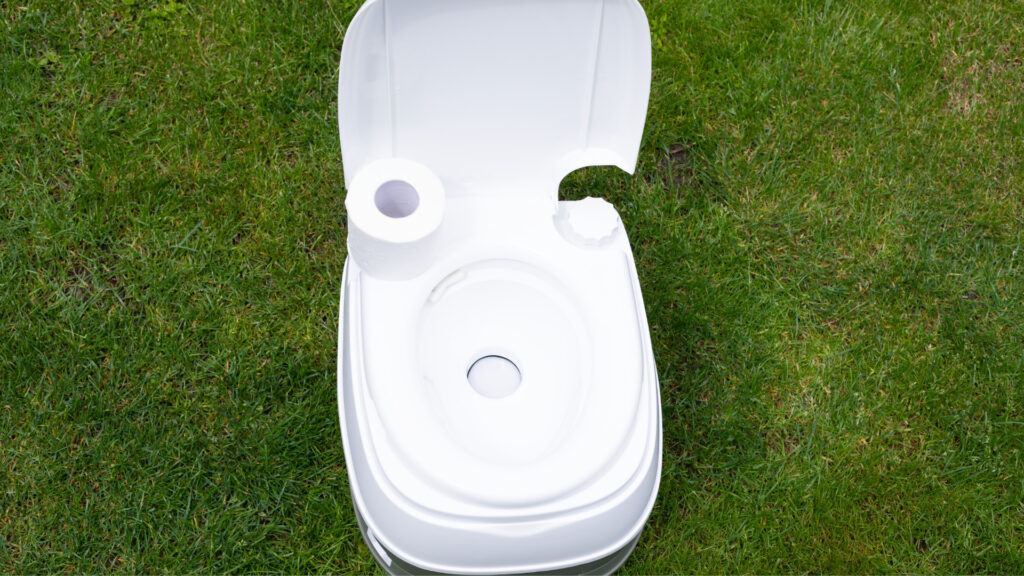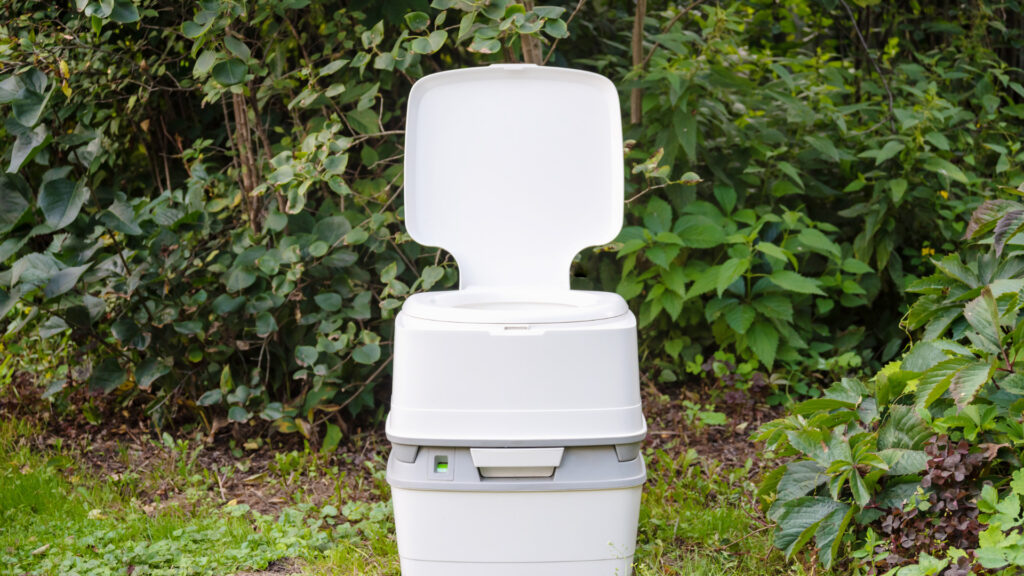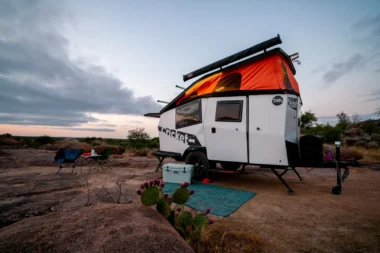Table of Contents Show
RVers and campers who want to stay off the grid or people who want to be more environmentally friendly have turned to waterless toilets.
The use of waterless toilets, particularly composting toilets, helps RVers and campers reduce their reliance on large, bulky reservoirs.
Though they might not be the perfect option for everyone, waterless toilets have become popular. Let’s delve into what it is, how it works, our top picks, and their benefits and drawbacks.
About Waterless Toilets
Waterless toilets are toilets that do not require water to flush. You can find many different kinds, but they all work by using some type of alternative to water to move waste out of the bowl and into a separate container.
One of the most common waterless toilets is the composting toilet, which uses bacteria to break down waste.
Others use chemical toilets or incinerating toilets, which burn it instead.
Waterless toilets have many benefits, including being more water-efficient and less likely to cause sewer overflows.
They can also work in areas with water shortages or for people that simply want to reduce their water usage.

How Does a Waterless Toilet Work?
One of the best options for a waterless toilet is a composting toilet. It uses a process of decomposition to treat human waste.
The waste enters a chamber where it mixes with carbon-rich material, such as sawdust, straw, peat moss, or coconut coir.
Over time, heat, moisture, and bacteria break down the waste, creating a safe, nutrient-rich compost.
Composting toilets offer a sustainable alternative to traditional flush ones by minimizing water usage while getting rid of human waste.
Keep in Mind: It can be a huge mess when your toilet leaks, so you’ll need to know how to fix it yourself. Check out how to troubleshoot your leaking RV toilet
Pros of a Waterless Toilet
Waterless toilets offer many benefits. The primary one is that they use less water.
This is good for the environment since it conserves water. They also don’t create wastewater that requires treatment before being released.
They usually require less cleaning since it has no water bowl or tank to worry about.
In addition, they come with a self-contained composting system.
This means that you don’t have to worry about dealing with the waste in an environmentally friendly way.
Cons of a Waterless Toilet
Waterless toilets have some drawbacks to consider. For example, they require increased maintenance.
Unlike flushing toilets, which rely on water to carry away waste, you have to empty composting toilets manually.
Many may not enjoy the messy and unpleasant task, particularly if you don’t clean it regularly.
In addition, waterless toilets can be more expensive than traditional ones, as they require specialized equipment and maintenance products.
Finally, they produce a strong odor if not properly maintained and ventilated.

Do Waterless Toilets Stink?
Though they can stink if not properly maintained, these toilets generally don’t stink because they don’t use water to flush away waste.
Instead, the composting or evaporation will break down the material.
As a result, they don’t produce the same type of foul-smelling odors that traditional toilets can
However, they can still produce unpleasant smells if not properly ventilated.
Additionally, you need to clean them regularly to prevent the build-up of bacteria and other contaminants.
Waterless Toilet Buying Options
There are numerous waterless toilets on the market, but we have narrowed our list to the top three.
All but one are composting toilets, which are more versatile than other options.
In The Know: Looking for normal RV toilets? Make sure you get the Best RV Toilet to Make Your Camping Experience More Comfortable
Nature’s Head Self Contained Composting Toilet
- No one - and I mean no one - will beat my customer service and individual support
- Easy to install by any reasonably handy person.
The Nature’s Head Self Contained Composting Toilet is a waterless toilet that uses minimal water and no chemicals.
You can easily install and maintain it, and it works great for small spaces such as RVs, boats, and cabins.
The Nature’s Head toilet uses an aerobic composting process to break down human waste. And it has a vent fan that helps keep the area odor-free.
You can also use the compost generated by the toilet as fertilizer for plants.
Additionally, you don’t have to empty it for four to six weeks with two people using it full-time.
It is an environmentally-friendly option for those who want to reduce their impact on the planet.
OGO Self Contained Waterless Toilet for RVs
- ODORLESS: The separation function effectively prevents the formation of odors. By avoiding chemicals and water, you are...
- BUILT TOUGH: Manufactured and assembled in Ohio, USA with quality built in. Clean and simple design holds up to 550lbs.
The OGO Self Contained Waterless Toilet for RVs is another great option for anyone looking for an environmentally friendly and water-efficient toilet.
It’s perfect for dry camping or boondocking. It uses a small amount of chemical solution to break down waste.
The OGO Self Contained Waterless Toilet is also very easy to use.
Simply add the chemical solution to the toilet bowl before use, and then flush with a small amount of water.
It is a great way to save water and reduce your environmental impact while camping or RVing.
Separett Tiny Waterless Toilet
The Separett Tiny Waterless Toilet is an innovative product that offers a convenient and eco-friendly alternative to traditional flush toilets.
It doesn’t use water for flushing, meaning it doesn’t require plumbing. Instead, it uses some sawdust or wood chips to absorb waste and odors.
You can use it in indoor and outdoor settings, making it ideal for RVs, camping trips, small homes, and boats.
Additionally, the Separett Tiny is easy to install and use. It works great for those wanting an efficient and eco-friendly way to manage their waste.
How Often Do You Have to Empty a Waterless Toilet?
How often you need to empty your waterless toilet will depend on a few factors, such as how many people use it, how much water gets flushed, and the frequency of use.
They work by separating solid and liquid waste. Which one you need to empty more frequently depends on usage and the holding tank capacity.
The liquid can also smell worse than the solids, so it may require more frequent dumping depending on its ventilation.
On average, you will probably need to empty it every two to three weeks.
However, if you find it fills up faster, you may need to dump it more often.
Conversely, if you don’t use it as much, you can stretch out the intervals between emptying.
Ultimately, keep an eye on your toilet and empty it whenever necessary to keep it in good order and reduce the possibility of unpleasant odors.
Keep in Mind: If you struggle with not having enough storage in your RV bathroom, this is a must read. You’ll love these RV bathroom storage ideas!
How Much Does a Waterless Toilet Cost?
While you can find many options, a quality composting toilet can cost around $1,000 to $2,000.
You can get cheaper ones but with less capacity. A toilet that macerates or incinerates will also cost much more.
Save Water with a Waterless Toilet
Waterless toilets are an increasingly popular choice for people looking to save water, particularly for RVers and campers.
These toilets use little or no water to flush and rely on a system of holding tanks and composting material to break down waste.
While they require a bigger initial investment and maintenance than traditional ones, the long-term water savings can be significant.
However, they won’t work for everyone. But if you are willing to put in the extra effort, they can be a great way to save water and reduce your impact on the environment.
Would you ever use a composting toilet?
Last update on 2024-07-26 / Affiliate links / Images from Amazon Product Advertising API










How do waterless toilets work? Let’s dive in. I think not!!!!